Pet ownership is facing big challenges. Knowing what to feed your cat is more important than ever. There’s been a 34% rise in cats left in shelters.
This rise matches the pandemic’s increase in pet adoptions. Now, about 12 million cats live in UK homes. Owners are finding it hard to give their cats the care and food they need because of rising costs and housing issues.
Finding the right cat food can be tough. But it’s key for your cat’s health and happiness. This guide will help you understand what to feed your cat for a happy, healthy life.
Table of Contents
The Importance of Feline Nutrition
Proper nutrition is key for our cats’ health. Cats are both hunters and hunted. This makes their diet needs complex. Giving them the right cat nutrition keeps them healthy and stops nutritional deficiencies.
How Diet Affects Cat Health
A cat’s diet affects their health and behavior. Bad nutrition can cause weight issues, digestive problems, and skin issues. It’s important to give them the right mix of nutrients for their health.
Common Nutritional Deficiencies
- Protein deficiency can result in muscle wasting and poor coat condition.
- Vitamin A deficiency may cause vision problems and poor growth.
- Calcium and phosphorus imbalances can lead to bone and tooth issues.
- Taurine deficiency is associated with heart and eye problems in cats.
The Role of Hydration in Cat Nutrition
Drinking enough water is crucial for cats. Many cats don’t drink enough, leading to urinary problems and dehydration. Giving them fresh water and wet food helps keep them hydrated.
“Cats are both predators and prey, making it challenging to meet their complex nutritional needs. Proper balanced cat nutrition is essential for maintaining their overall cat health and preventing nutritional deficiencies.”
Understanding cat nutrition helps them live long, healthy lives. By meeting their nutritional needs, we can ensure their well-being.
Key Nutritional Components for Cats
Cats need certain nutrients for good health and to live long lives. Proteins, fats, and carbs are very important for them.
Proteins: The Building Blocks
Proteins are key for a cat’s body. They help grow, fix, and keep tissues, muscles, and organs strong. Cats need animal-based proteins like meat, poultry, and fish.
Fats: Essential Fatty Acids
Fats are crucial for a cat’s health. They give energy, boost the immune system, and keep skin and fur healthy. Omega-3 and omega-6 fatty acids are very important for cats.
Carbohydrates: A Controversial Topic
The role of carbs in a cat’s diet is debated. Some say cats do well on low-carb diets. Others think some carbs are good for them.
It’s important to give cats a diet that fits their needs. Knowing about these nutrients helps pet owners choose the best food for their cats.
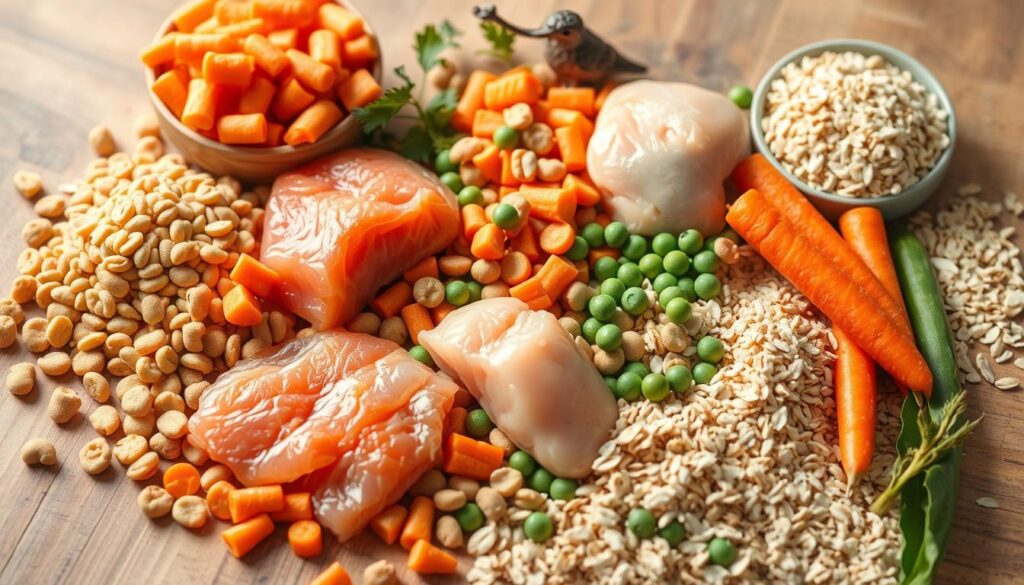
Understanding Cat Food Labels
Choosing the right food for your cat is important. Cat food labels give you lots of info. They help you pick the best food for your cat’s diet.
Decoding Ingredients Lists
The ingredients list on cat food labels is key. Look for high-quality protein sources like chicken, beef, or fish. Avoid foods with many fillers, by-products, or artificial stuff.
Nutritional Information Analysis
Check the nutritional info panel on the label. It shows if the food meets your cat’s needs. Make sure it has the right amounts of proteins, fats, carbs, and vitamins.
Understanding the AAFCO Statement
The AAFCO statement on labels means the food meets their standards. It shows the food is good for your cat’s health and growth.
Knowing what cat food labels say helps you choose well. You can pick the best food for your cat’s health and happiness.
Types of Cat Food Available
Pet owners have many cat food options. Each type—dry, wet, and raw—has its own good and bad points. Knowing these can help you pick the best food for your cat.
Dry Food: Pros and Cons
Dry cat food is easy to store and serve. It’s also cheaper. But, it might not keep your cat hydrated well. This is bad for cats with urinary problems.
Wet Food: Nutritional Benefits
Wet cat food has more moisture. This is good for your cat’s health and can help with weight. It also tastes better to cats, making them eat more.
Raw Diet: What to Consider
Raw diets are made of uncooked meat and bones. They might be healthier for cats. But, they can be risky. Always talk to a vet before trying a raw diet.
Choosing the right cat food depends on your cat’s needs and your lifestyle. Think about the pros and cons of each. Always talk to your vet to find the best food for your cat.
| Cat Food Type | Pros | Cons |
|---|---|---|
| Dry Food |
|
|
| Wet Food |
|
|
| Raw Diet |
|
|
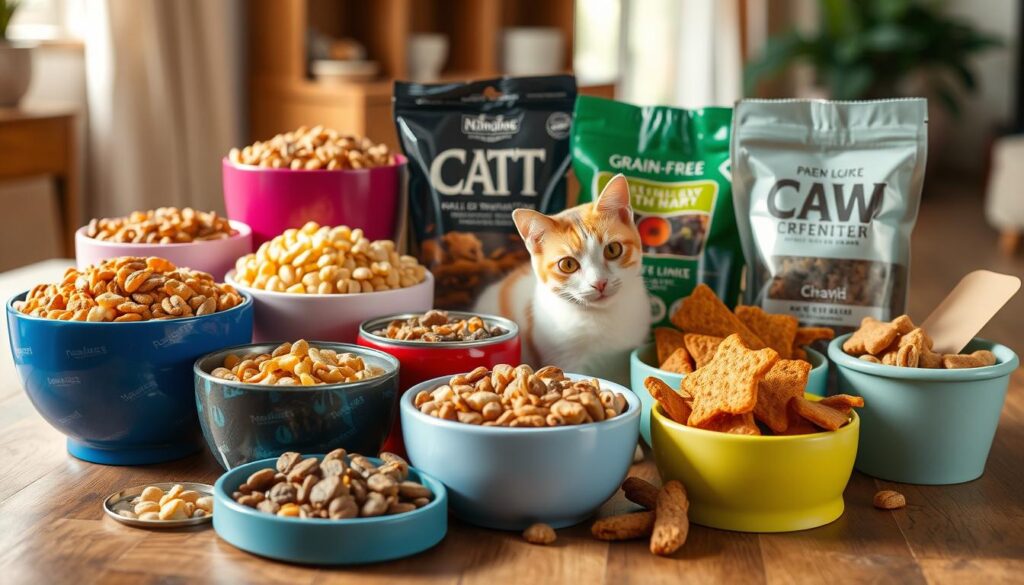
Special Dietary Needs for Cats
Cats need different foods as they get older. Kittens, senior cats, and cats with special needs have special needs. It’s important to know what they need to stay healthy.
Kittens: Nutritional Requirements
Kittens need lots of kitten nutrition. They need more protein and calories for growing fast. They also need vitamins and minerals for strong bones and a healthy body.
Senior Cats: Adapting Their Diet
Older cats need special food. Their senior cat diet should help with aging problems like kidney disease and arthritis. They might need less protein and fat to stay healthy.
Special Conditions: Allergies and Sensitivities
Some cats have cat food allergies. This can cause skin problems, stomach issues, or breathing problems. Finding out what they’re allergic to and avoiding it is key.
| Condition | Symptoms | Dietary Considerations |
|---|---|---|
| Food Allergies |
|
|
| Kidney Disease |
|
|
Every cat is different. They need special food to stay healthy and happy all their lives.
Homemade vs. Commercial Cat Food
Feeding your cat is a big decision. You can choose between homemade or commercial cat food. Each has its own good points and things to think about. It’s all about what’s best for your cat and what you can do.
Benefits of Homemade Diets
Homemade cat food lets you pick what goes into it. This means your cat gets a diet made just for them. You can use fresh, high-quality ingredients and avoid bad stuff in some commercial foods.
Risks of Home-Cooked Meals
Homemade cat food sounds great, but it’s not without risks. Making sure your cat gets all the nutrients they need is hard. If you don’t get it right, your cat could get very sick.
Choosing Quality Commercial Brands
Commercial cat food can be a good choice too. Look for brands that follow the rules and use experts to make their food. Good brands make sure their food is balanced and healthy for cats.
Choosing between homemade and commercial cat food depends on you. It’s about how much time and effort you can put into it. Talking to your vet can help you decide what’s best for your cat.
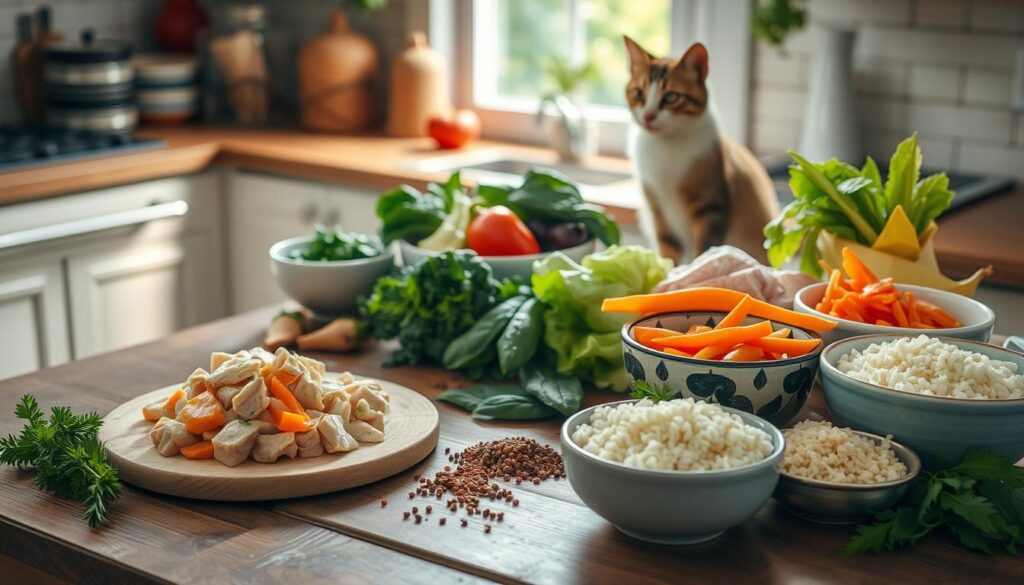
Feeding Schedules and Portion Control
Keeping a healthy cat feeding schedule and right portion control for cats is key. The right amount of food depends on your cat’s age, weight, and how active they are. Some cats do well with small meals often, while others like bigger meals less often.
Determining Portion Sizes
To find the right portion control for cats, think about your cat’s needs. Kittens and active cats need more food than older, less active cats. Feed your cat about 20-30 calories per pound of their weight each day. Adjust this based on how your cat looks and feels.
Frequency of Feeding
- Kittens and young cats do well with 3-4 small meals a day. This helps them grow fast and stay full of energy.
- Adult cats usually do best with 2-3 meals a day. This helps them keep a healthy weight.
- Older cats or those with special diets might need more frequent, smaller meals. This ensures they get the nutrients they need.
Monitoring Your Cat’s Weight
It’s important to watch your cat’s weight to keep them healthy. Weigh your cat often and check how they look. If their weight or appearance changes, you might need to adjust their food or talk to your vet.
| Healthy Cat Weight Range | Dry Food Portion (per day) | Wet Food Portion (per day) |
|---|---|---|
| 5-10 lbs | 1/2 – 1 cup | 1 – 3 cans (3 oz each) |
| 10-15 lbs | 1 – 1 1/2 cups | 2 – 4 cans (3 oz each) |
| 15-20 lbs | 1 1/2 – 2 cups | 3 – 5 cans (3 oz each) |
Understanding the importance of cat feeding schedules and portion control for cats helps your cat stay healthy. This way, your cat can live a happy and full life.
Treats and Snacks for Cats
Treats are great for training and bonding with cats. But, they should be given in small amounts. It’s important to choose healthy cat treats that are good for your cat’s diet.
These treats help with cat training with treats. They make your cat learn good things and make your bond stronger.
Choosing Healthy Treats
Choose treats that are low in calories and have no bad additives. They should have good proteins, fats, and natural stuff. Don’t pick treats with too much sugar, salt, or bad stuff.
The Role of Treats in Training
Treats can help teach your cat new things. Give them a treat when they do something right. This helps them learn and want to do it again.
But, don’t give too many treats. It’s important to keep it balanced.
Avoiding Overindulgence
Don’t give too many treats. Too many can make your cat fat and unhealthy. Watch how many calories the treats have.
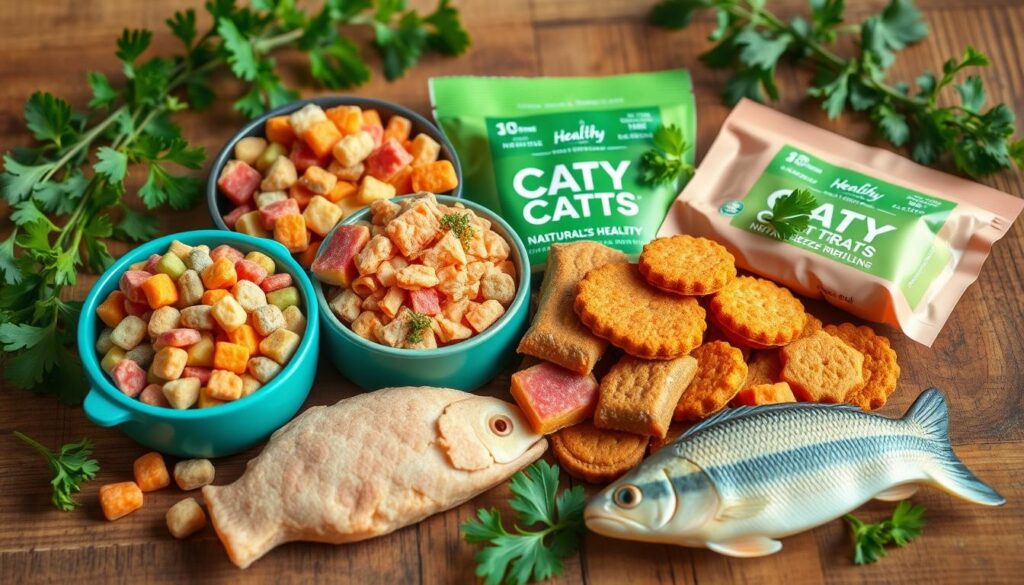
Common Myths About Cat Nutrition
Many myths about cat food can confuse pet owners. It’s important to know the truth about cat nutrition. This knowledge helps keep your cat healthy and happy. Let’s look at some common myths and clear them up with expert advice.
Debunking Popular Misconceptions
One big myth is that cats can live on plant-based diets. But cats need animal proteins to stay healthy. A diet without animal proteins can harm their health.
Another myth is that milk is good for adult cats. Kittens need their mom’s milk, but adult cats don’t. Drinking milk can upset their stomachs.
Understanding Myths vs. Facts
- Myth: Cats need to eat grass regularly.
- Fact: Cats might eat grass sometimes. But it’s not a must. Eating grass can mean they’re bored or have a tummy ache.
- Myth: Cats should be fed a high-protein diet.
- Fact: Cats do need protein, but too much can hurt their kidneys and liver. A balanced diet is best.
Expert Opinions on Feline Diet
Vets and nutritionists stress the need to know what your cat needs. “Cats need specific foods that can’t be the same for everyone,” says Dr. Emily Carlson. “Talking to your vet to make a special diet plan is the best way to keep your cat healthy.”
Knowing the truth about cat food helps pet owners make better choices. Talking to vets and keeping up with new research can help. This way, your cat will stay happy and healthy.
Transitioning Your Cat to a New Diet
Changing your cat’s diet is a careful step. It’s important to make sure it’s done right. This way, your cat stays healthy and happy. First, you need to know when your cat might need a diet change.
Signs Your Cat Needs a Diet Change
Changes in your cat’s health or weight might mean it’s time for a new diet. If your cat has ongoing digestive issues, or if they’re gaining or losing weight without reason. Or if they’re getting older, it’s a good idea to talk to your vet about food options.
Tips for a Smooth Transition
- Start by mixing the new food with the old one over 7-10 days. Slowly add more of the new food.
- Begin by mixing the old and new foods together. This helps your cat get used to the new taste and texture.
- Make sure your cat always has clean, fresh water. This is important for their hydration.
Monitoring Your Cat’s Response
Watch how your cat reacts to the new diet closely. Look at their appetite, stool quality, and energy levels. If you see any big changes, talk to your vet right away. With patience and watching closely, you can help your cat adjust well to the new diet.
| Indicator | Ideal Observation |
|---|---|
| Appetite | Maintained or increased |
| Stool Quality | Firm, well-formed |
| Energy Levels | Consistent or improved |
“Transitioning your cat’s diet requires patience and vigilance, but the rewards of a healthier, happier feline are well worth the effort.”
Consulting with a Veterinarian
Keeping your cat healthy and well-fed needs regular vet visits. A vet can help with health issues, diet problems, or big diet changes. They know how to make a special diet plan for your cat’s age, health, and life.
When to Seek Professional Guidance
Take your cat to the vet even if they seem fine. These visits help the vet check your cat’s health and diet. If your cat’s eating, weight, or coat changes, see the vet right away.
Importance of Regular Checkups
Going to the vet often is key to your cat’s health. The vet can do a full check, tests, and give diet advice. This helps find and fix health problems early and makes a diet plan just for your cat.

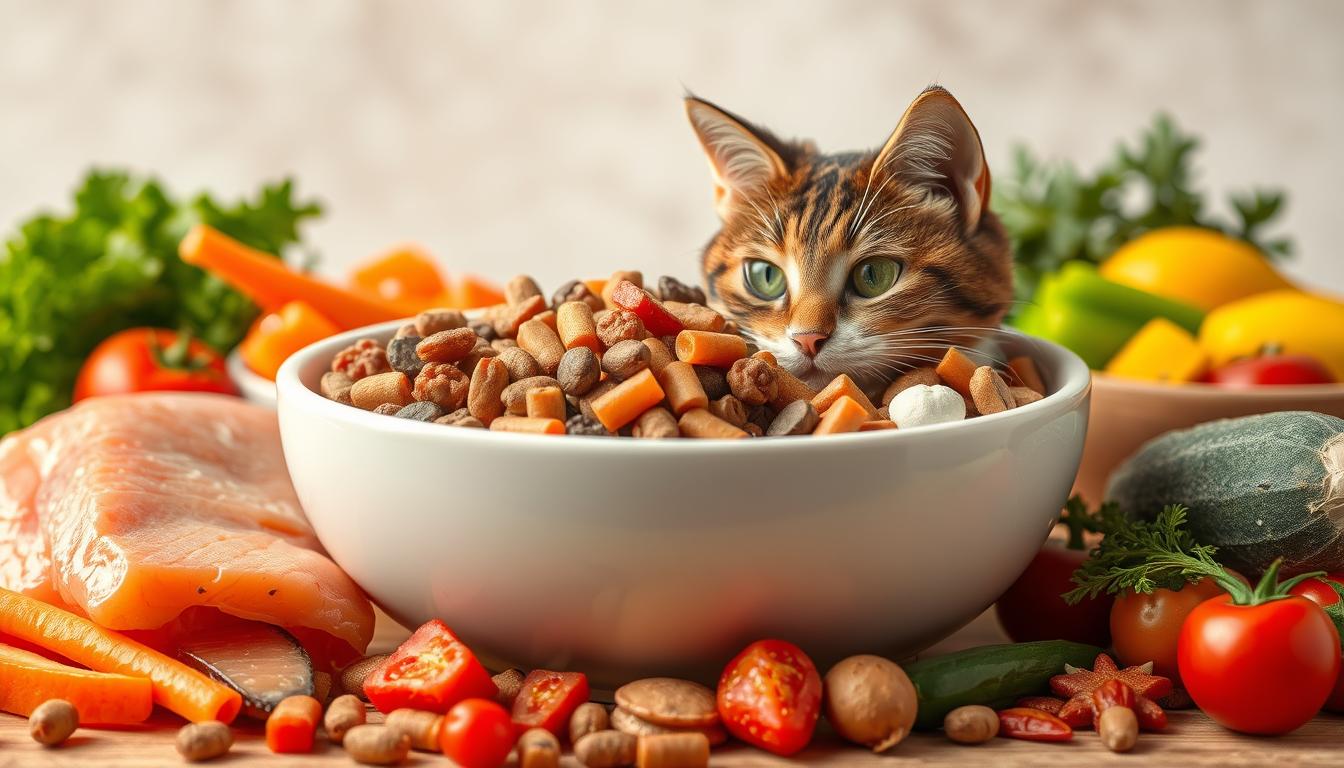
2 thoughts on “Understanding Feline Nutrition: What to Feed Your Cat for Optimal Health”
Comments are closed.